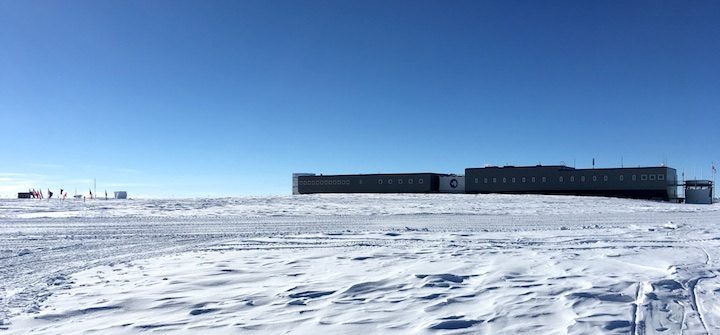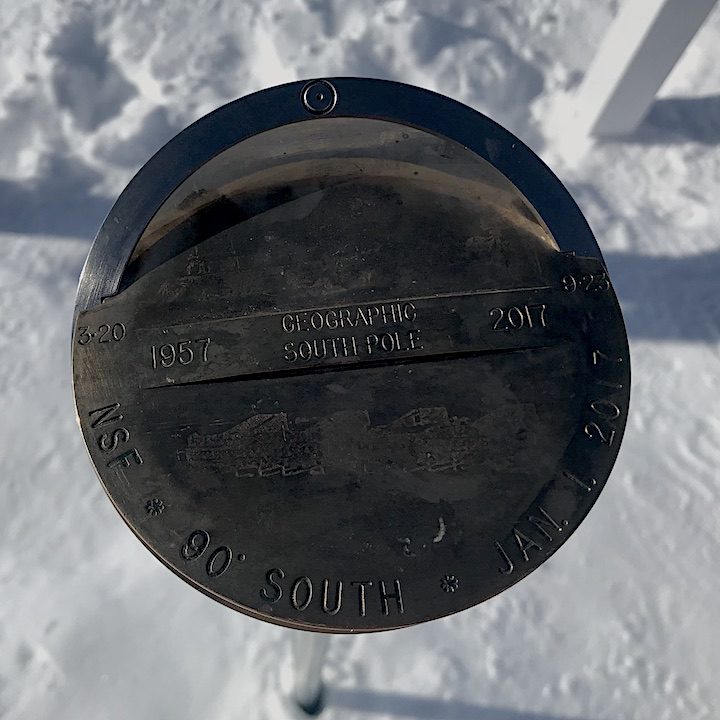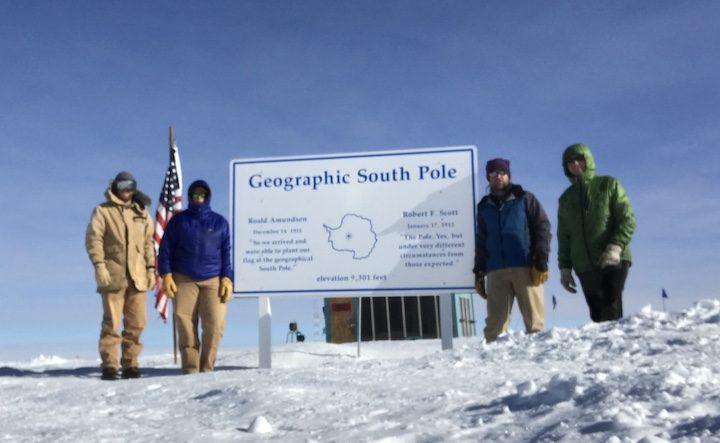

After a few extra days in the seaside town of McMurdo Station, we flew on a ski-equipped LC-130 for the sunny environs of South Pole Station, where we had a flawless touchdown on the groomed skiway next to the station. This is our last stop before embarking on the traverse in about a week. Our main objective here is to prepare our vehicles and sleds for travel, and take some cool pictures.

The team at the bottom of the world.
The Amundsen-Scott South Pole station is located right at 90 degrees south latitude (ok, maybe not exactly there, but the station is within about 100m of 90 S). It’s named for the Norwegian explorer Roald Amundsen, who first set foot here in December of 1911, and for the British explorer Robert F. Scott, who followed closely behind in January 1912. The United States established a station here in 1957 as part of the International Geophysical Year, and it has been continuously occupied ever since. The current station, commissioned in 2008, is the third major station the U.S. Antarctic Program has built here. The prior station (the iconic geodesic dome) was disassembled and sent back to the US.

The elevated design of the station is intended to reduce snow drift, a major consideration when building structures on the ice sheet.
We are here in the height of the summer season, and there are ~150 people on station making the most of the relatively warm weather (-30 C, or -22F) for construction projects, moving cargo, and of course, science projects like ours. In winter, the station is much quieter with around 40 people spending the long winter keeping the station running.
For the first few days we’re here, our main job is to do very little. The South Pole Station sits on top of the East Antarctic Ice Sheet at about 10,000 feet above sea level, which is a big jump from the sea level McMurdo Station. The keys to acclimatization are to drink plenty of water and avoid exercise, though a little walking is fine. After about three days, we will be cleared to move on to more vigorous activities.

The 2017 geographic south pole marker.
There is a marker placed at the geographic South Pole, designed by the wintering crew at the station. Every year on January 1, the new marker is placed and the marker from the past year is put on display inside the station. Since the entire station (and skiway, and cargo, and traverse vehicles) are on top of the ice sheet, the whole station moves along with the ice. The ice shifts about 30 feet per year toward the 40 degrees west line of longitude where it eventually becomes part of the Filchner-Ronne ice shelf. (Don’t worry though, at the current velocity, it will take tens of thousands of years to get there.)
The perhaps more familiar scene is from the ceremonial south pole – a post with barbershop stripes and a reflective ball on top, surrounded by the flags of nations signing the original Antarctic treaty. The two poles are a few hundred yards apart and are both worth a visit if you find yourself down this way. Tell ‘em Tom sent you.

The team at the geographic south pole: Forrest McCarthy, Tom Neumann, Kelly Brunt, and Chad Seay.
Earlier today, we visited our cargo that we shipped from McMurdo and had a look at our sleds. It looks like everything has arrived, and as soon as our breath catches up with us, we will begin packing the sleds and pitching our tents!
-Tom and Kelly
By Bob Bindschadler
McMurdo (Antarctica), 12 December — Well, nearly a week has whizzed by. We have been quite busy, but it doesn’t feel like there’s been much real progress. Every day seems to come with its own set of new problems and developments. This includes cargo hunting (yes, it was still going on until recently—but it’s DONE now), remembering some item or tool that would probably prove useful (then finding it and getting it) or thinking of some small thing to build and then getting the carpenters or machinists to understand what we want, (then waiting for the item, packing it and getting it into the cargo system.)
Tying up these loose ends didn’t add much weight to our overall cargo load, but we knew we were going to be heavier than we had planned for because there were some heavy items that failed to make it on flights to Byrd Station, where the over snow traverse was going to be taking them to the main camp at Pine Island. These problems originated way back in early September: Early season weather in West Antarctica was worse than usual, which meant fewer flights to Byrd and less of our cargo getting there when the traverse needed to start. Without sufficient cargo, the traverse managers held their departure back a few days. When they tried to start, one of the large tractors failed, leaving them with only three. This actually worked out better, since there was less cargo to pull. Now we hear that the traverse is encountering soft snow, slowing its progress even more. The image below is a map of the traverse’s progress through last night. It’s averaging less than 4.5 miles per hour and under 60 miles per day: At this rate, it will be another five days before it arrives at PIG.
It’s a polar tortoise and hare race. The traverse is undoubtedly the tortoise, but the hare is having its own difficulties. Flights to PIG take “only” 5 hours (one-way) and were scheduled every day since Wednesday last week (except Sunday). Each one of them was cancelled because of bad weather at one or more of the required landing spots: McMurdo, Byrd or PIG. Good weather at Byrd is necessary to refuel the plane on its way home. Today’s weather looked the best of all days and, unlike last week’s flights, the plane actually took off from McMurdo. But two hours into the 5-hour flight, the weather went bad at Byrd. WAIS is another nearby station that could refuel the aircraft, but weather also went bad in there not long after. So the plane was ordered back to McMurdo before it was so far away and had so little fuel that it would get stuck somewhere out in the middle of West Antarctica.
It’s anybody’s guess who will get to PIG first: the traverse or the put-in flight. The traverse is more important, because it has the heavy equipment to dig out all the camp material left there at the end of last season (a small camp was set up then), groom the runway used last season (if the flags marking it can be found, that is) and tap into the all-important fuel bladder. Getting to that fuel is key because with it the LC-130 cargo planes (called “Hercules” or “Hercs”, for short) can get enough fuel to get back to McMurdo without having to stop at Byrd or WAIS. This will make missions to PIG less susceptible to weather cancellations.
Our cargo handling is done. But, as I mentioned, since now we have to fly some items that didn’t get to Byrd by the traverse’s departure, our stuff weighs more than planned. Whether that requires another flight will not be decided until we hear if the groomed runway at PIG can handle heavier landing weights. It’s all connected: cargo, tractors, fuel, airplanes and weather. Meanwhile, we will make our case for moving our necessary science cargo up in the queue, so we don’t suffer more delays.
It’s not all bad news. These past few days have contained some bright spots. Our project has received a lot of attention. A Blue Ribbon Panel, here last week to assess the effectiveness of the US Antarctic Program, really likes the social relevance of our mission and its interdisciplinary character. I gave a science lecture on PIG to a packed audience and got superb reviews. Many people here have touched the project in one way or another and I wanted them to understand what it was about and why we have to go to someplace that is so hard to get to. I also was singled out to prepare a poster and speak to the Prime Minister of Norway, who is flying to the South Pole to mark the 100th anniversary of Roald Amundsen’s trip.
Attention is great; more progress would be even better!